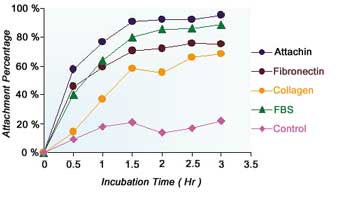
|
GENTAUR EUROPE BELGIUM1 tel +32 2 732 5688 fax +32 2 732 4414 [email protected] Av. de l' Armée 68 B-1040 Brussels France tel 01 43 25 01 50 fax 01 43 25 01 60 9, rue Lagrange 75005 Paris Italy tel 02 36 00 65 93 fax +32 16 50 90 45 20135 Milano Germany tel +32 16 58 90 45 fax +32 16 50 90 45 Forckenbeckstraße 6 D-52074 Aachen Japan tel +81 78 386 0860 fax +81 78 306 0296 Minaatojimaminami-manchi Chuo-ku, Kobe 065-0047 |
Attachin, a fusion protein with molecular weight of 30 kDa, is demonstrated to stimulate cell attachment. Both hydrophilic and hydrophobic polymer have been shown to be effective as the attachment surface.
Various types of cells promptly attach to the surface precoating Attachin in half an hour, and then spread in the media with or without serum supplement.
Attachment efficiency of Attachin is better than that of collagen or fibronectin.
Attachin has been used in the culture of smooth muscle cells and bladder epithelium cells of dog, bone marrow stem cells of human, cartilage cells of rabbit, mouse fibroblasts applied in artificial skin, capillary vessels, artificial bone and joins.
Attachin also can be used in the production of vaccine and therapeutic protein in a high cell density culture system or serum-free culture system.
|
|
||
Attachin - Cell Attachment ReagentAttachin has been shown to stimulate cell attachment on hydrophilic cellulose material as well as hydrophobic polymers. Attachin enhances bioadhesive property of biomaterial, form a stable tissue structure, so that it is a perfect intermediate between biomedical material and cells. It can enhance attachment of epidermis, endodermis, and cartilage cells - especially in tissue engineering - including artificial skin, bone, cartilage, blood vessel, and other artificial tissues. Attachin helps cells attach and grow in tissue and promotes secretion of growth factors and extracellular matrix making artificial tissue stable like a natural tissue. Attachin helps to produce vaccine and protein in high-density cell culture with microcarriers. In a stir-bioreactor, Attachin can help cells attach stably and promptly on microcarriers and reduces cell damage caused by mechanical shear force.
|
||
Features and Advantages:
|
Feature
|
|||
|
|
|||
Function
|
|||
|
|
|||
Usage and Advantage
|
|||
|
|
|||
Targets
|


